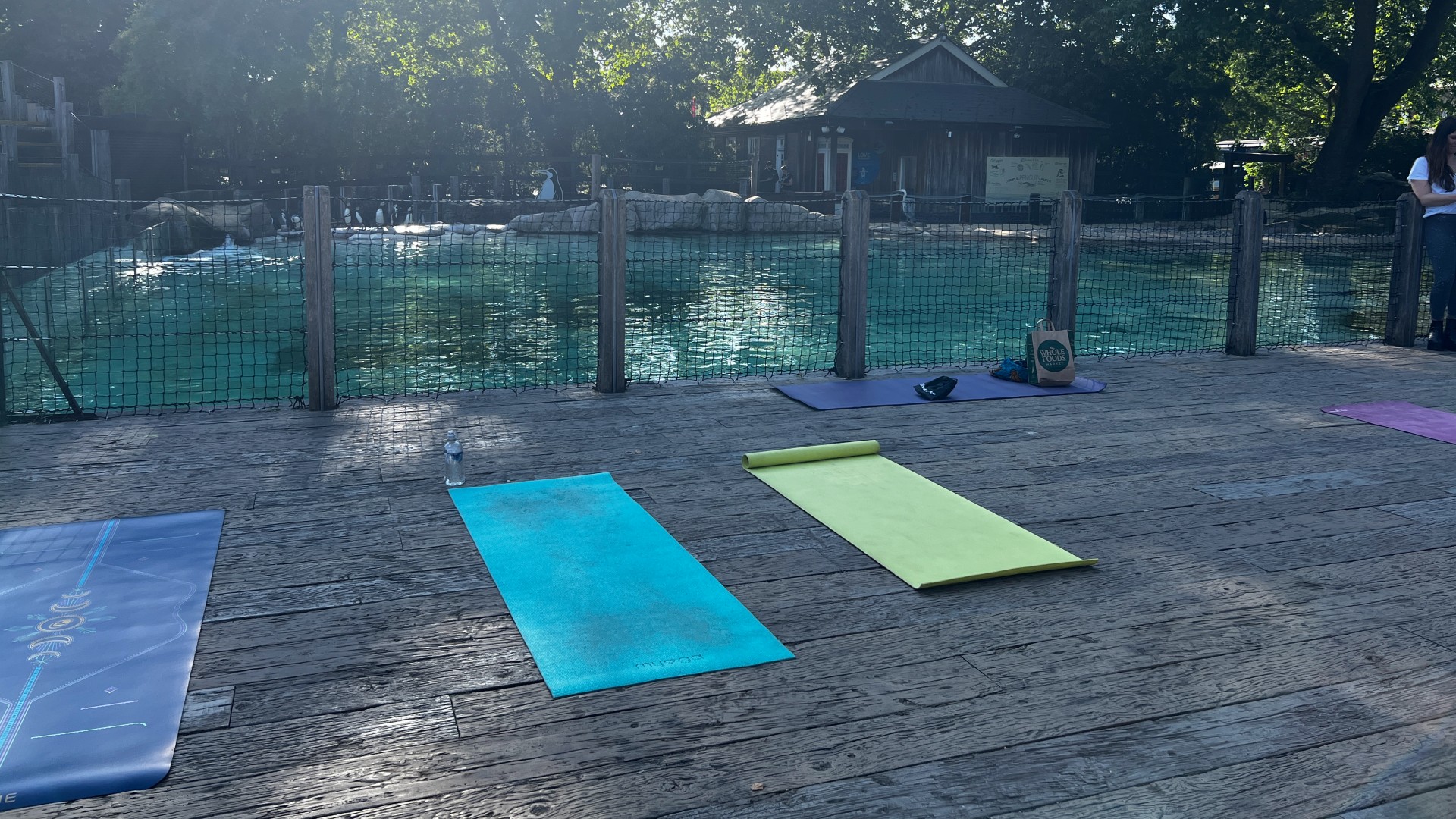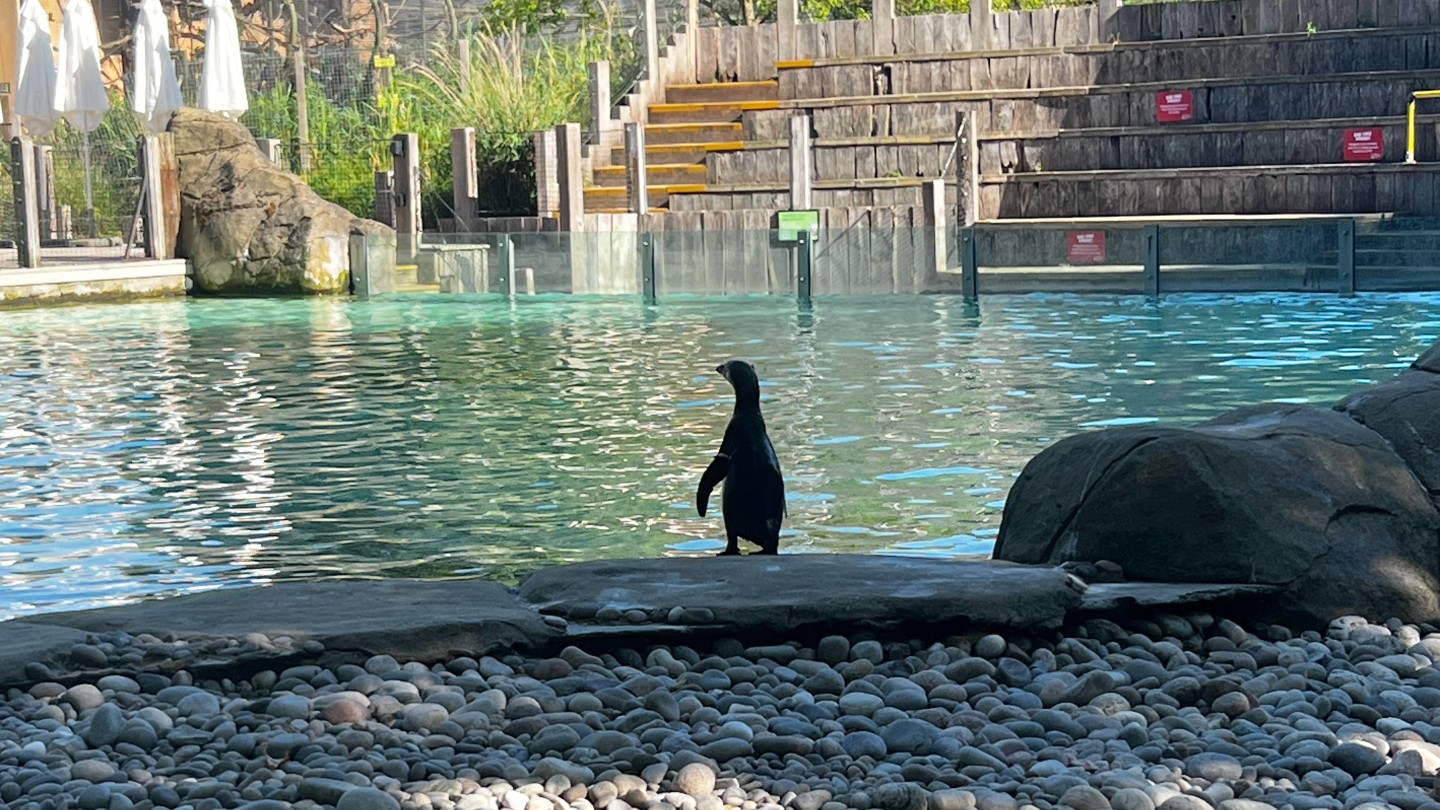
In celebration of the International Day of Yoga, what better way to give it a nod than heading to a penguin yoga class? From goat yoga to puppy yoga, you can flow with just about any animal, these days. We just love bending and stretching with a bunch of animals.
I hadn’t heard about penguin yoga before, so imagine my surprise when I got invited to join a 60-minute vinyasa yoga class at no other than the renowned Penguin Beach at London Zoo with East of Eaden yoga studio.
Flow through an outdoor yoga class set amongst a colony of 60 Humboldt penguins to celebrate the summer solstice and all things yoga (and penguins). Count me in. Not one to turn down this rare opportunity, I slung one of the best yoga mats for workouts underneath my arm and practically ran to class. Here’s what happened.
What is penguin yoga?

Penguin yoga does what it says on the tin — you’ll practice 60 minutes of outdoor vinyasa yoga amongst a colony of penguins. That said, penguins are pretty robust animals — I worked in a penguin rehabilitation center in Cape Town, South Africa, and subsequently received six stitches in my lip as a result of a particularly snappy penguin — so sadly, letting them loose on the mats wasn’t an option.
I tried 50 minutes of penguin yoga for the first time — here’s what happened
Aimed to be peaceful, playful and great for mindfulness, the class offers a chance for a “moment of calm” while “flowing with the rhythms of nature, so that you can fully immerse in the present moment” which is essentially what yoga is all about. Here’s what I learned in 60 minutes.
It's more than a fad — and the research backs it

You could view this as another fad, and I’d get it. But there’s research to support the benefits of spending time with animals and exercising in nature — both of which have a soothing effect on the autonomic nervous system, sending the body from fear-based fight-or-flight (that pesky but vital sympathetic nervous system) to the parasympathetic, which is a place of calm and repair.
For example, one study published in Nature found that your environment could be just as important when considering exercise, citing that “time spent in natural outdoor environments has been found to lead to increases in cognition similar to those resulting from acute exercise.” The study also supports the benefits of combining exercise and nature for better brain function.
Another study, published by Frontiers in Psychology, found that animal-human interaction can increase oxytocin levels (the “love hormone”) and promote social interaction, which we know is good for humans, while reducing stress and anxiety. The study even claims single meetings with animals can trigger oxytocin effects in humans.
It was incredibly relaxing
As I gently flowed through a 60-minute vinyasa class led by our yoga instructor (whose teacher was no other than Shiva Rea), the sun-dappled floor, gentle summer breeze and sound of penguins slicing through cool water provided a seriously yogic-calm backdrop; I could feel the day’s stress melting off my body as the summer solstice drew in, and it was meditative.
Interacting with animals has been shown to lower cortisol levels, but I’ve always found that being outdoors has the most meditative effect on my mind and body, and this was like mindfulness on steroids. I left feeling incredible, and I usually reserve that word only for my hot yoga classes.

It was a good distraction — but the class was still testing
I’m relieved the class wasn’t style over substance, and it was testing enough that I left with a gentle sweat, feeling more flexible, calm and stretchy. There were moments of digging deep (endless Reverse Warriors) and my heart rate raised as I moved through the thoughtful, expansive and mindful sequencing — perfect for opening arms to the summer solstice.
The sun-dappled floor, gentle summer breeze and sound of penguins slicing through cool water provided a seriously yogic-calm backdrop.
Some research claims nature can provide some of the “best all-around health benefits by increasing physical activity levels with lower levels of perceived exertion,” which can reduce stress, restore mental fatigue, boost mood and self-esteem and act as a “natural medicine.” Funnily enough, penguins braying in the background can help distract you from spending five breaths in Warrior I.
It made me laugh, which boosted my mood
They say laughter is medicine, and there’s a growing body of research into laughter therapy, self-induced laughter and even laughter yoga. I challenge you to keep a straight face (and your balance) during Tree Pose while a penguin waddles across a rock just in front of you.
But it’s great news if you want the science to back it up — research published by the American Journal of Lifestyle Medicine shows that laughing is linked to “chemical changes in the body that potentially reduce stress and increase pain tolerance,” which can create positive physiological changes in people who are regularly prescribed laughter. Maybe I need to play penguin YouTube videos during yoga classes from now on?

My verdict on 60 minutes of penguin yoga:
Fad or no fad — I loved it. If I want to spend 60 minutes feeling calm, happy and full of laughter, I know penguin yoga will deliver, although finding a regular class could be a problem.
Spending time with animals and in nature offers a double whammy for promoting feelings of relaxation and mindfulness. Interacting with animals can reduce cortisol levels and blood pressure, reduce loneliness and increase self-esteem.
Moreover, the benefits of breathing exercises — yoga brings together pranayama (breath) and asana (postures) — include lower heart rate, reduced anxiety and better mood.
Despite what people might say about yoga (often ones who have never actually tried a class), it isn’t “easy.” And when you look at the physical, emotional and mental benefits, it’s pretty amazing what an hour of yoga can do for your body over the long term, especially a calming mindful yoga practice; this includes building stronger bones and muscles, boosting flexibility and improving mindfulness.







